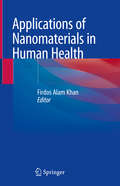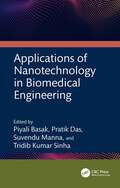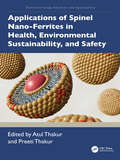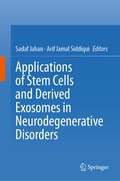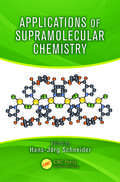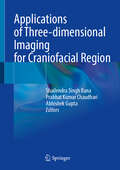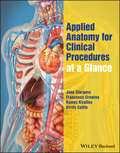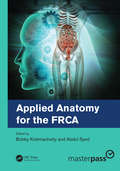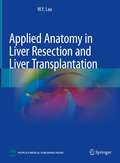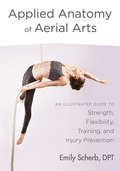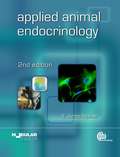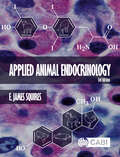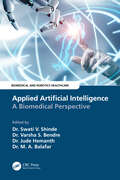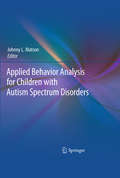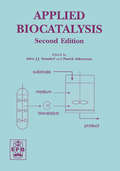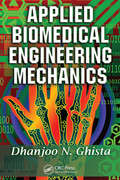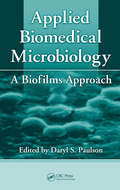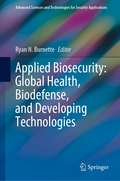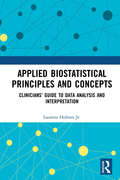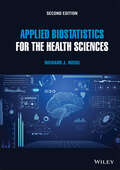- Table View
- List View
Applications of Microfluidic Systems in Biology and Medicine (Bioanalysis #13)
by Manabu TokeshiThis book is the second edition of the one originally published in 2016, which focused on state-of-the-art microfluidic research in medical and biological applications. Similar to the first edition, beginners in the field —undergraduates, engineers, biologists, medical and pharmaceutical researchers—will easily learn to understand microfluidic-based medical and biological applications. Because a wide range of topics is summarized here, it also helps experts to learn more about fields outside their own specialties. In this second edition, significant revisions have been made to chapters covering technologies that have seen major advancements, such as acoustofluidics, protein crystallography, organ-on-a-chip systems, nanopore sensing, and paper-based microfluidics. In addition, the chapters on cancer diagnosis using exosomes and single-cell sequencing using droplet microfluidics, which are attracting attention as new technologies, have been newly added. Readers will be convinced that microfluidic devices have great potential for medical and biological applications.
Applications of Nanomaterials in Human Health
by Firdos Alam KhanThis book reviews the various applications of nanotechnology in human health. The introductory chapters focus on the classifications, types, synthesis, and characterization of various types of nanomaterials, while subsequent chapters highlight current applications of nanomaterials in the diagnosis and treatment of microbial and viral infections, and also in stem cell biology and regenerative medicine. Further, the book explores the potential role of nanomaterials in connection with neuronal differentiation, neuronal protection, and neurological diseases. It demonstrates the use of nanotechnology to diagnose and treat genetic disorders, as well as endocrine and metabolic syndrome diseases. It also discusses the ethics and the negative impacts of nanomaterials on human health. Lastly, it examines the intellectual property aspects and government regulations associated with the research, design, and commercialization of nanotechnology-based products. Given its scope, it offers a valuable resource for all researchers and professionals working with nanotechnology-based applications in human health.
Applications of Nanotechnology in Biomedical Engineering
by Suvendu Manna Piyali Basak Pratik Das Tridib Kumar SinhaThis book presents recent advancements in nanotechnology-based innovations in the biomedical sciences and engineering fields, including nanoimaging, nano-delivery of drugs and genes, antimicrobial and antiviral coatings, nano-neutraceuticals, and nano-cosmetics. It covers a wide range of topics, which include nanosensors, nano-based coatings, and wound healing, as well as scope for new research and development. It is a guide to the state-of-the-art nanotechnological advancements in medical image processing and disease detection. Features are as follows: Covers industry-oriented applications of nanomaterials in the field of biomedical engineering Discusses development of nature-inspired nano-engineered nutraceuticals Reviews research on nano-coating to restrict biofilm formation and nosocomial infections Includes different aspects of both medical sciences and health sciences, ranging from medical imaging to cosmetics Explores micro-/nano-SMART devices for biomedical applications This book is aimed at researchers and graduate students in biomedical engineering, nanotechnology, and related areas.
Applications of Spinel Nano-Ferrites in Health, Environmental Sustainability, and Safety (Nanotechnology Advances and Applications)
by Atul Thakur Preeti ThakurThis book presents the foundational concepts of spinel nano-ferrites, their synthesis techniques, and their cutting-edge applications in various fields. The book begins with an introduction to spinel nano-ferrites, discussing their unique properties and historical context. It then delves into various synthesis techniques, such as sol-gel methods, co-precipitation, and hydrothermal processes, highlighting the influence of these methods on the resultant structures and morphologies. The book also reviews the electrical and magnetic characteristics of spinel nano-ferrites, demonstrating their potential in electronic and magnetic devices. The role of spinel nano-ferrites in the health sector is explored in depth, detailing their use as antibacterial and antifungal agents and their innovative applications in magnetic resonance imaging (MRI), cancer detection, targeted drug delivery, and hyperthermia treatment. The chapters further examine the environmental applications of spinel nano-ferrites, including their effectiveness in pollution remediation, water purification, dye degradation, and the detection and removal of heavy metal ions and microplastics from wastewater. Toward the end, the book explores the development of gas sensors and humidity sensors using spinel nano-ferrites, as well as devices designed for human and environmental safety. This book is intended for researchers and students of nanotechnology, nanobiotechnology, healthcare professionals, and environmental scientists.Key Features: Covers foundational concepts, unique properties, and cutting-edge applications of spinel nano-ferrites Explores various synthesis methods such as sol-gel, co-precipitation, and hydrothermal processes, and their impact on structures and morphologies of spinel nano-ferrites Discusses the electrical and magnetic characteristics of spinel nano-ferrites Examines the potential of spinel nano-ferrites as antibacterial and antifungal agents, and their roles in MRI, cancer detection, and drug delivery Highlights the effectiveness of spinel nano-ferrites in pollution remediation, water purification, and dye degradation
Applications of Stem Cells and derived Exosomes in Neurodegenerative Disorders
by Sadaf Jahan Arif Jamal SiddiquiThis book explores the therapeutic approaches of stem cells and stem cell-derived exosomes against neurodegenerative disorders (NDDs). The initial chapters introduce different neurodegenerative diseases and discuss the mechanistic aspects of their progression. The subsequent chapters cover strategies for the isolation, characterization, and differentiation of stem cells. In turn, the book reviews the protective role of stem cells against neurological disorders and examines regenerative approaches to treat neurological diseases using mesenchymal stem cells. The book also presents induced pluripotent stem cell (iPSC) technology for cellular therapy, drug screening, and in-vitro modeling of neurodegenerative diseases. Lastly, the book discusses the role of stem cells and derived exosomes as a novel therapeutic agent against Alzheimer's and Parkinson's disease and in associated signaling molecules involved in neuroprotection. This book is an invaluable source for researchers working towards understanding the potential of stem cell therapy in neurodegenerative disorders.
Applications of Supramolecular Chemistry
by Hans-Jörg SchneiderApplications of Supramolecular Chemistry introduces the use of non-covalent interactions and molecular recognition for many fields. Applications include the analysis of technically, medically, and environmentally important chemical compounds, their separation, purification and removal, and the design of new materials, including supramolecular elect
Applications of Three-dimensional Imaging for Craniofacial Region
by Abhishek Gupta Prabhat Kumar Chaudhari Shailendra Singh RanaThe book provides sound knowledge of 3D imaging of dentofacial craniofacial region. It guides the students and faculty for understanding the dentofacial craniofacial region in depth. It incorporates the latest techniques, frameworks and technologies in the imaging area of oral health. The book emphasizes on the dentofacial and craniofacial region and thus fills the gap in the medical imaging literature. The development in this book is not only on the imaging techniques but also emphasis will be on the three-dimensional (3D) frameworks to deal the patients for their diagnosis and treatment planning. The chapters of this book are designed in such a way that the readers may get the complete package of the exploration of the imaging clinical applications of craniofacial areas. This book will be helpful not only for the students and faculty but also for the researchers working in the relevant areas.This book will provide easy, simple way but the most authentic material to learn the craniofacial region imaging. In this manual we will incorporates authentic, internationally accepted terms and definition. To make it interesting and simple, our approach is to incorporate the material in systematic manner in a simple and easy way by incorporating maximum illustrations and flowcharts. This book provides sound knowledge of various advanced technologies for dentist imaging. This book will highlights the importance and explore the current research in the dentofacial and craniofacial areas.
Applications of the Universal Thermal Climate Index UTCI in Biometeorology: Latest Developments and Case Studies (Biometeorology #4)
by Eduardo L. KrügerThis book introduces the UTCI (Universal Thermal Climate Index) and summarizes progress in this area. The UTCI was developed as part of the European COST Action Program and first announced to the scientific community in 2009. Since then, a decade has followed of applicability tests and research results, as well as knowledge gained from applying the UTCI in human adaptation and thermal perception. These findings are of interest to researchers in the interdisciplinary areas of biometeorology, climatology and urban planning. The book summarizes this progress, discussing the limitations found and provides pointers to future developments. It also discusses UTCI applications in the areas of human biometeorology and urban planning including possibilities of using UTCI and similar indices in climate-responsive urban planning. The book’s message is illustrated with many case studies from the real world.Chapter 10 is available open access under a Creative Commons Attribution 4.0 International License via link.springer.com.
Applied Anatomy for Clinical Procedures at a Glance (At a Glance)
by Jane Sturgess Ramez Kirollos Francesca Crawley Kirsty CattleApplied Anatomy for Clinical Procedures at a Glance is a concise resource combining high-quality images and step-by-step instructions to provide expert guidance on the major core training pathways in medicine, surgery and anaesthesia. Written by an experienced team of Foundation Training programme directors and clinical skills examiners, this unique revision and learning guide aligns with training pathways rather than anatomical area to support Foundation doctors and core trainees master these vital clinical procedures. Succinct yet thorough descriptions of each procedure include photographs of surface anatomy, line diagrams of the anatomy, instructions on the procedural techniques, and practical tips for performing the procedures safely whilst minimising risks of complications. All major aspects of Foundation procedures and Core training in applied anatomy are covered, including catheterisation, ECGs, central venous cannulation, basic suturing and anastomotic techniques, endotracheal intubation, epidural injection and spinal injection, defibrillation, and many others. Helps Foundation doctors and Core trainees apply their medical school knowledge in clinical settings Explains the common anatomical pitfalls of invasive clinical procedures Features practice questions on anatomy and clinical aspects to aid in preparing for clinical skills examinations Includes sections on aftercare and on specific equipment, including manometers and underwater seals Applied Anatomy for Clinical Procedures at a Glance is ideal for Foundation doctors and Core trainees, as well as medical students, physician’s assistants and surgical scrub practitioners.
Applied Anatomy for the FRCA
by Bobby Krishnachetty and Abdul SyedApplied Anatomy for the FRCA covers the anatomical knowledge that trainee anaesthetists who are revising for the Primary and Final FRCA exams will need. The topics covered are derived from the FRCA curriculum and include the most up-to-date version of past exam questions, in order to ensure targeted and successful exam revision. The content, illustrations and overall layout of this book ensure that common gaps in anatomical knowledge encountered by FRCA trainees are included. This reference is divided into sections pertaining to anatomical regions: head and neck, thorax, abdomen, spine, and the upper and lower limbs. The topics of importance to anaesthetists are presented under ‘structures’, ‘circulation’ and ‘nervous system’ (with relevance to regional anaesthesia). Each topic is extensively researched and presented in a simple format for maximum retention. This book makes learning and remembering applied anatomy as straightforward as possible. Applied Anatomy for the FRCA supplements the knowledge required by trainee anaesthetists appearing for the FRCA exams. Clinical educators will also find it useful in teaching. It serves as a practical reference for anatomical knowledge at any point in an anaesthetist’s career. About the Editors Dr Bobby Krishnachetty has been a Consultant Anaesthetist at Southend University Hospital since 2010 and a college tutor for six years. She completed her diploma in medical education and is the author of The Final FRCA Structured Oral Examination: A Complete Guide. She is also the organiser of the regional teaching for Core trainees in the East of England school of anaesthesia, as well as Founder of the ‘Southend Viva Club’ Primary and Final FRCA SOE revision courses for more than nine years, and Cofounder of MRCS OSCE webinars. Mr Abdul Syed has been a Consultant Surgeon at Southend University Hospital since 2015. He is Lead for postgraduate teaching of surgical trainees, Cofounder of MRCS OSCE webinars and conducts Core surgical trainee interview skills courses. Mr Syed is also an Assessor for medical school interviews and an active participant in QI projects and research.
Applied Anatomy in Liver Resection and Liver Transplantation
by W.Y. LauThis book has 20 chapters which cover a full range of knowledge about liver anatomy before one embarks on carrying out a liver operation on a patient. The knowledge ranges from external to internal anatomy of the liver, from pure anatomy to its application in liver operations, from vascular infiow/outflow of the liver to techniques used in reducing intraoperative blood loss, from Couinaud's liver segments to segment- based liver resection, and from the different approaches to liver resectional techniques to the different types of liver transplantation. The particular feature of this book is the heavy use of diagrams which makes reading easier. Surgeons in liver resection and liver transplantation in will find this book of value as a reference book.
Applied Anatomy of Aerial Arts: An Illustrated Guide to Strength, Flexibility, Training, and Injury Prevention
by Emily ScherbAn illustrated guide to anatomy and biomechanics for aerialists who want to optimize their performance and train safelySpecifically designed for aerialists—including those who do trapeze, silks, and other aerial arts— Applied Anatomy of Aerial Arts is an invaluable resource for those who want to optimize their performance and train safely. Using a biomechanical and movement-based approach, Emily Scherb—a physical therapist who specializes in the care, treatment, and education of circus performers—explains the anatomical rationale for progressions of learning and demonstrates simple movements to achieve the coordination, muscular control, strength, and fitness to hang with correct form, how to progress from hanging into a pull up, an inversion, and beyond with a strong center, precise muscle sequencing, and ease of movement. Aerialists will learn how bones, joints, muscles, and soft tissues allow for specific movements and gain an appreciation for concepts of proximal stability. This full-color illustrated guide lays a solid foundation for beginners and advanced students with a wealth of insights into their own performance as well as refreshers on fundamentals in warm ups and conditioning. It explains how to structure a training session, how to care for injuries, and best practices for basic self first aid.
Applied Animal Endocrinology
by E. James SquiresThis textbook explains the role of hormones in improving and monitoring the production, performance, reproduction, behaviour and health of animals. With its focus on livestock animals: cattle, pigs, sheep and horses as well as poultry and fish; the book uses an integrative approach to cover endocrine concepts across species. This updated edition is expanded to include new topics in each section, with updated references, revised study questions and an expanded subject index. It is an essential text for students in animal and veterinary sciences as well as those in academia and industry that are interested in applications of endocrinology in animal production systems. Praise for the first edition: '...a useful text for teaching purposes and an important reference for those who seek ready access to information on specific aspects of applied endocrinology.' Poultry Science
Applied Animal Endocrinology
by E. James SquiresThis book explains the role of hormones in improving and monitoring the production, performance, reproduction, behaviour and health of livestock animals, focusing on cattle, pigs, sheep, horses, poultry and fish. Beginning with the principles of endocrinology and the methods to study endocrine systems, it then covers the different endocrine systems that affect different aspects of animal production and describes how these systems can be manipulated or monitored to advantage. The mechanism of action is covered, and common mechanisms and themes highlighted in order to understand potential methods for altering these systems, and stimulate ideas for the development of new methods. A refreshed, updated resource that highlights new areas of endocrinology with applications in commercial animals, additions to this new edition include: - information on G protein receptors, function of CREB, methods for identification of DNA regulatory sequences and DNA binding proteins, circadian rhythm and the biological clock; - expanded coverage of in vitro models to include 3D cell culture and organ-on-a-chip; - new knowledge on gene editing, antibody production, hormone delivery methods and DNA cloning and sequencing methods; - the role of the gut microbiome, as well as effects of antibiotics and antimicrobials; - skin as an endocrine organ and related information on wool production and endocrine defleecing; - updated information on protocols for assessing endocrine disruptor chemicals. An invaluable text for students of animal science and veterinary medicine, this book also provides a useful resource for those in academia and industry interested in applications of endocrinology in animal production systems.
Applied Antifragility in Natural Systems: From Principles to Applications (SpringerBriefs in Computer Science)
by Roman Bauer Cristian Axenie Oliver López Corona Jeffrey WestAs coined in the book of Nassim Taleb, antifragility is a property of a system to gain from uncertainty, randomness, and volatility, opposite to what fragility would incur. An antifragile system’s response to external perturbations is beyond robust, such that small stressors can strengthen the future response of the system by adding a strong anticipation component. Such principles are already well suited for describing behaviors in natural systems but also in approaching therapy designs and eco-system modelling and eco-system analysis. The purpose of this book is to build a foundational knowledge base by applying antifragile system design, analysis, and development in natural systems, including biomedicine, neuroscience, and ecology as main fields. We are interested in formalizing principles and an apparatus that turns the basic concept of antifragility into a tool for designing and building closed-loop systems that behave beyond robust in the face of uncertainty when characterizing and intervening in biomedical and ecological (eco)systems. The book introduces the framework of applied antifragility and possible paths to build systems that gain from uncertainty. We draw from the body of literature on natural systems (e.g. cancer therapy, antibiotics, neuroscience, and agricultural pest management) in an attempt to unify the scales of antifragility in one framework. The work of the Applied Antifragility Group in oncology, neuroscience, and ecology led by the authors provides a good overview on the current research status.
Applied Artificial Intelligence: A Biomedical Perspective (Biomedical and Robotics Healthcare)
by Jude Hemanth Swati V. Shinde Varsha S. Bendre M. A. BalafarThis book explores the advancements and future challenges in biomedical application developments using breakthrough technologies like Artificial Intelligence (AI), Internet of Things (IoT), and Signal Processing. It will also contribute to biosensors and secure systems,and related research. Applied Artificial Intelligence: A Biomedical Perspective begins by detailing recent trends and challenges of applied artificial intelligence in biomedical systems.Part I of the book presents the technological background of the book in terms of applied artificial intelligence in the biomedical domain. Part II demonstrates the recent advancements in automated medical image analysis that have opened ample research opportunities in the applications of deep learning to different diseases. Part III focuses on the use of cyberphysical systems that facilitates computing anywhere by using medical IoT and biosensors and the numerous applications of this technology in the healthcare domain. Part IV describes the different signal processing applications in the healthcare domain. It also includes the prediction of some human diseases based on the inputs in signal format. Part V highlights the scope and applications of biosensors and security aspects of biomedical images.The book will be beneficial to the researchers, industry persons, faculty, and students working in biomedical applications of computer science and electronics engineering. It will also be a useful resource for teaching courses like AI/ML, medical IoT, signal processing, biomedical engineering, and medical image analysis.
Applied Behavior Analysis Treatment of Violence and Aggression in Persons with Neurodevelopmental Disabilities (Advances in Preventing and Treating Violence and Aggression)
by James K. LuiselliThis book focuses on applied behavior analysis (ABA) treatment of violence and aggression in persons with neurodevelopmental disabilities. It details ABA theory and concepts leading to empirical treatment procedures that can be implemented successfully across diverse treatment settings. Further, the book examines contemporary approaches to functional behavioral assessment (FBA) and functional analysis (FA) in determining the environmental conditions responsible for violence and aggression. In addition, the volume describes several evidence-supported treatment procedures that encompass antecedent-control, contingency management, cognitive-behavior therapy, and physical intervention components. It addresses effective strategies for training and supervising care providers, including behavioral skills training (BST), posttraining performance management, and mindfulness. Finally, the book presents recommendations that guide effective and socially valid research-to-practice translation. Applied Behavior Analysis Treatment of Violence and Aggression in Persons with Neurodevelopmental Disabilities is an essential resource for researchers, clinicians/therapists, and upper-level undergraduate and graduate students in forensic psychology, public health, criminology/criminal justice, and behavioral therapy and rehabilitation.
Applied Behavior Analysis for Children with Autism Spectrum Disorders
by Johnny L. MatsonAutism was once thought of as a rare condition, until the Centers for Disease Control and Prevention's Autism and Developmental Disabilities Monitoring Network released the statistic that about 1 in every 150 eight-year-old children in various areas across the United States is afflicted by an autism spectrum disorder, or ASD. This news led to a dramatic expansion of research into autism spectrum disorders and to the emergence of applied behavior analysis (ABA) as the preferred method of treatment, even among prescribing practitioners. Applied Behavioral Analysis for Children with Autism Spectrum Disorders ably synthesizes research data and trends with best-practice interventions into a comprehensive, state-of-the-art resource. Within its chapters, leading experts review current ABA literature in depth; identify interventions most relevant to children across the autism spectrum; and discuss potential developments in these core areas: Assessment methods, from functional assessment to single case research designs. Treatment methods, including reinforcement, replacement behaviors, and other effective strategies. The role of the differential diagnosis in ABA treatment planning. Specific deficit areas: communication, social skills, stereotypies/rituals. Target behaviors, such as self-injury, aggression, adaptive and self-help problems. ASD-related training concerns, including maintenance and transition issues, and parent training programs. This volume is a vital resource for researchers, graduate students, and professionals in clinical child and school psychology as well as the related fields of education and mental health.
Applied Biocatalysis
by Adrie J.J. Straathof Patrick AdlercreutzDescribing the essential steps in the development of biocatalytic processes from concept to completion, this carefully integrated text combines the fundamentals of biocatalysis with technological experience and in-depth commercial case studies. The book starts with an introductory look at the history and present scope of biocatalysis and proceeds t
Applied Bioinformatics (2nd Edition): An Introduction
by Paul M. Selzer Oliver Koch Richard J. MarhöferThis book introduces readers to the basic principles of bioinformatics and the practical application and utilization of computational tools, without assuming any prior background in programming or informatics. <P><P>It provides a coherent overview of the complex field and focuses on the implementation of online tools, genome databases and software that can benefit scientists and students in the life sciences. Training tutorials with practical bioinformatics exercises and solutions facilitate the understanding and application of such tools and interpretation of results. In addition, a glossary explains terminology that is widely used in the field. This straightforward introduction to applied bioinformatics offers an essential resource for students, as well as scientists seeking to understand the basis of sequencing analysis, functional genomics and protein structure predictions.
Applied Biomedical Engineering Mechanics
by Dhanjoo GhistaPresenting the latest innovations, this text highlights advances in tissue, musculoskeletal, locomotive, orthopedic, occupational, ergonomic, sports, cardiovascular, cardiac, and pulmonary biomechanics. Based on years of teaching experience, the author uses illustrative examples and detailed explanations to show how mechanics disciplines can be applied to a wide range of clinical applications, including the analysis of physiological and organ-system processes; the creation of physiologically compatible organ-assist systems and devices; the performance of pre-surgical analysis in order to develop optimal surgical approaches; and the design of vehicle-occupant systems for occupant comfort.
Applied Biomedical Microbiology: A Biofilms Approach
by Daryl S. PaulsonFrom the slippery covering on rocks in a stream, to the clogging slime in a bathtub drain, biofilms are present in everyday life in a variety of forms. This seemingly harmless build-up also accounts for 80 percent of all microbial infections. With chapters authored by experienced contributors from academia and industry, Applied Biomedical Microbiol
Applied Biosecurity: Global Health, Biodefense, and Developing Technologies (Advanced Sciences and Technologies for Security Applications)
by Ryan N. BurnetteThis book describes an adaptable biothreat assessment process to complement overall biorisk management programs, incorporating threat management and the unique natures of biological assets. Further, this book examines the nexus between public health, international security, and developing technologies, building a case for augmenting biosecurity to levels beyond the laboratory constraints. With the face of biological and biomedical sciences changing, this book describes how with proper biosecurity development, these can become assets, rather than liabilities, to secure our world from natural and man-made biological disasters. The world is changing rapidly with respect to developing threats, such as terrorism, and dual-use technologies, such as synthetic biology, that are challenging how we think about biosafety and biosecurity. Further, the fields of public health and international security are colliding, as both of these share the common enemy: intentional or natural biological incidents. To date, biosecurity has been limited to laboratory-level application, and complicating efforts, and lacks credentialed biosecurity professionals skilled in both the biological sciences and threat management techniques. The result is a fragmented field of practice, with tremendous need, from the lab to the outbreak. Underpinning these principles is the SARS-CoV-2 coronavirus pandemic, providing a historic milestone to examine biosecurity through a global lens. This book describes biosecurity as a set of practices and principles to be augmented out of the constrained laboratory environment, and applied to larger efforts, such as international threat reduction and biological incident management.
Applied Biostatistical Principles and Concepts: Clinicians' Guide to Data Analysis and Interpretation
by Laurens Holmes, Jr.The past three decades have witnessed modern advances in statistical modeling and evidence discovery in biomedical, clinical, and population-based research. With these advances come the challenges in accurate model stipulation and application of models in scientific evidence discovery Applied Biostatistical Principles and Concepts provides practical knowledge using biological and biochemical specimen/samples in order to understand health and disease processes at cellular, clinical, and population levels. Concepts and techniques provided will help researchers design and conduct studies, then translate data from bench to clinics in attempt to improve the health of patients and populations. This book is suitable for both clinicians and health or biological sciences students. It presents the reality in statistical modelling of health research data in a concise manner that will address the issue of "big data" type I error tolerance and probability value, effect size and confidence interval for precision, effect measure modification and interaction as well as confounders, thus allowing for more valid inferences and yielding results that are more reliable, valid and accurate.
Applied Biostatistics for the Health Sciences
by Richard J. RossiAPPLIED BIOSTATISTICS FOR THE HEALTH SCIENCES APPLIED BIOSTATISTICS FOR THE HEALTH SCIENCES In this newly revised edition of Applied Biostatistics for the Health Sciences, accomplished statistician Dr. Richard Rossi delivers a robust and easy-to-understand exploration of statistics in the context of applied health science and biostatistics. The book covers sample design, logistic regression, experimental design, survival analysis, basic statistical computation, and many more topics with a strong focus on the correct use and interpretation of statistics. The author also explains how to assess the quality of observed data, how to collect quality data, and the use of confidence intervals in conjunction with hypothesis and significance tests. A thorough introduction to biostatistics, including explanations of fundamental concepts like populations, samples, statistics, biomedical studies, and data set examples A comprehensive exploration of population descriptions, including qualitative and quantitative variables, multivariate data, measures of dispersion, and probability Practical discussions of random sampling, summarizing random samples, and the measurement of the reliability of statistics In-depth examinations of confidence intervals, statistical hypothesis testing, simple and multiple linear regression, and experimental design Perfect for health science and biostatistics students and professors at the upper undergraduate and graduate levels, Applied Biostatistics for the Health Sciences is also a must-read reference for practitioners and professionals in the fields of pharmacy, biochemistry, nursing, health care informatics, and the applied health sciences.

